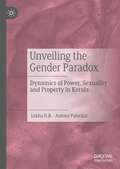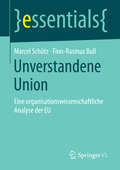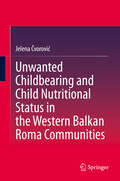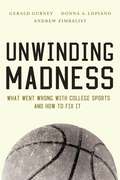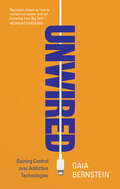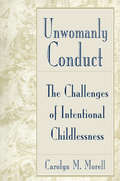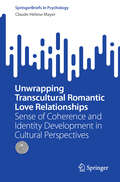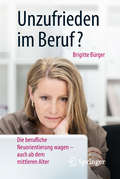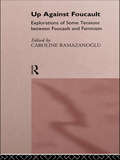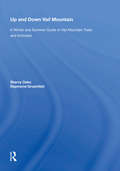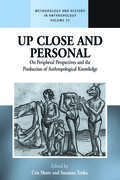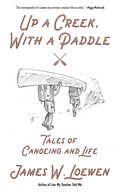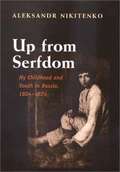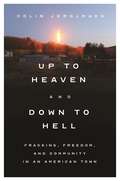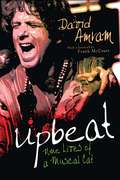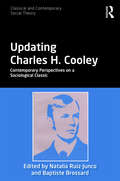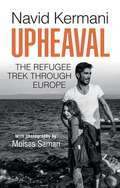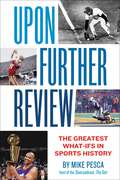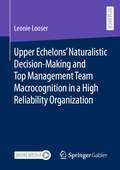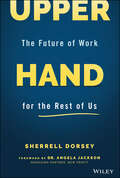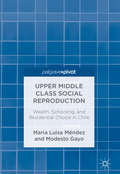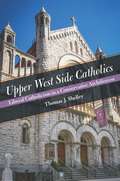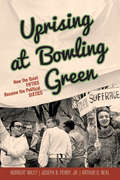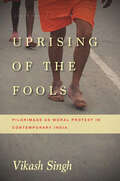- Table View
- List View
Unveiling the Gender Paradox: Dynamics of Power, Sexuality and Property in Kerala
by Lekha N.B. Antony PalackalBoth nationally and internationally, the south Indian state of Kerala has been an object of study for its matrilineal kinship organization among some communities, as well as its achievements in education, literacy, and life expectancy for women against a weak economic base. Nonetheless, scholars have drawn attention to a paradox in Kerala’s model of development, namely women’s deteriorating social position in Kerala and the rise in violence against women. Against this backdrop, this book explores the intersections of gender, sexuality, marriage, family and kinship as related to the matrilineal Nayar community in Kerala. Chapters unravel the interplay between the triple categories of gender, power and social development as they play out at the micro, meso, and macro levels of society, probing the ways in which Nayar women practice agency. Ultimately, the authors explore how the strength of the Nayar community can be used as a case study toward circumventing the prevailing gender paradox and re-imagine a more liberated, empowered and self-reliant woman not only in Kerala, but in India at large. This book will be of interest to scholars in sociology, gender studies, and development studies, particularly those with a focus on South Asia.
Unverstandene Union: Eine organisationswissenschaftliche Analyse der EU (essentials)
by Marcel Schütz Finn-Rasmus BullMarcel Sch#65533;tz und Finn-Rasmus Bull gewinnen in einer organisationswissenschaftlichen Analyse neue Erkenntnisse #65533;ber die besonderen Organisationsmerkmale der oft als politisches B#65533;ndnis oder Projekt umschriebenen Europ#65533;ischen Union (EU). Hierzu bedienen sie sich eines bew#65533;hrten Strukturansatzes aus der Systemtheorie Niklas Luhmanns und verbinden diesen mit dem Konzept der Metaorganisation. Dargelegt wird, welche erschwerten Bedingungen der Steuerung und Ver#65533;nderung in solchen Organisationen auftreten, deren Mitglieder nicht Individuen, sondern ebenfalls Organisationen sind. Die Autoren zeigen, dass vermeintliche St#65533;rungen und Defizite der organisierten Staatengemeinschaft sich hintergr#65533;ndig als elementare St#65533;rken und Vorz#65533;ge erweisen k#65533;nnen.
Unwanted Childbearing and Child Nutritional Status in the Western Balkan Roma Communities
by Jelena ČvorovićThis book investigates the relationship between maternal investment, unwanted births, and child nutritional outcomes in five poor communities of the Western Balkan Roma. Based on an evolutionary approach, the book directly assesses variability in Roma mothers’ parental care using data from UNICEF Multiple Indicator Cluster Surveys 5 and 6 for the Roma settlements in Serbia, Montenegro, Kosovo, Macedonia, and Bosnia and Herzegovina. The book includes useful information about Roma communities in the Western Balkans and their history and sufferings in the region. It reviews this history against the data on unwanted childbearing globally and in low- and middle-income countries. It addresses concerns related to Roma people's integration into European society, despite their longstanding presence in Europe. The book analyses the existence of health differentials among Roma children themselves, suggesting that some children are especially vulnerable. Therefore, it critically assesses how multiple (levels of) vulnerabilities affect differential Roma parental investment in children. This book is a useful resource for researchers interested in Roma studies, children's well-being, wellbeing of marginal groups, social work and social justice.
Unwinding Madness: What Went Wrong with College Sportsand How to Fix It
by Andrew Zimbalist Gerald Gurney Donna A. LopianoA critical look at the tension between the larger role of the university and the commercialization of college sportsUnwinding Madness is the most comprehensive examination to date of how the NCAA (National Collegiate Athletic Association) has lost its way in the governance of intercollegiate athletics-and why it is incapable of achieving reform and must be replaced. The NCAA has placed commercial success above its responsibilities to protect the academic primacy, health and well-being of college athletes and fallen into an educational, ethical, and economic crisis.As long as intercollegiate athletics reside in the higher education environment, these programs must be academically compatible with their larger institutions, subordinate to their educational mission, and defensible from a not-for-profit organizational standpoint. The issue has never been a matter of whether intercollegiate athletics belongs in higher education as an extracurricular offering. Rather, the perennial challenge has been how these programs have been governed and conducted.The authors propose detailed solutions, starting with the creation of a new national governance organization to replace the NCAA. At the college level, these proposals will not diminish the revenue production capacity of sports programs but will restore academic integrity to the enterprise, provide fairer treatment of college athletes with better health protections, and restore the rights and freedoms of athletes, which have been taken away by a professionalized athletics mentality that controls the cost of its athlete labor force and overpays coaches and athletic directors.Unwinding Madness recognizes that there is no easy fix to the problems now facing college athletics. But the book does offer common sense, doable solutions that respect the rights of athletes, protects their health and well-being while delivering on the promise of a bona fide educational degree program.
Unwired: Gaining Control over Addictive Technologies
by Gaia BernsteinOur society has a technology problem. Many want to disconnect from screens but can't help themselves. These days we spend more time online than ever. Some turn to self-help-measures to limit their usage, yet repeatedly fail, while parents feel particularly powerless to help their children. Unwired: Gaining Control over Addictive Technologies shows us a way out. Rather than blaming users, the book shatters the illusion that we autonomously choose how to spend our time online. It shifts the moral responsibility and accountability for solutions to corporations. Drawing lessons from the tobacco and food industries, the book demonstrates why government regulation is necessary to curb technology addiction. It describes a grassroots movement already in action across courts and legislative halls. Groundbreaking and urgent, Unwired provides a blueprint to develop this movement for change, to one that will allow us to finally gain control.
Unwomanly Conduct: The Challenges of Intentional Childlessness
by Carolyn Mackelcan MorellFirst published in 1994. Routledge is an imprint of Taylor & Francis, an informa company.
Unwrapping Transcultural Romantic Love Relationships: Sense of Coherence and Identity Development in Cultural Perspectives (SpringerBriefs in Psychology)
by Claude-Hélène MayerThis research study explores the interlinkages of three major themes, namely transcultural romantic love relationships (TRLRs), sense of coherence (SOC), and identity development (ID) in individuals who are presently involved in romantic love relationships (RLR) with partners from different cultural or ethnic backgrounds. The study uses a qualitative research design within the hermeneutical interpretative research paradigm, aiming to understand the interlinkages of TRLR, SOC, and ID. Based on purposive and snowball sampling techniques, the study includes 22 participants (12 female and 10 male) between 23 and 68 years of age, from 14 different (self-defined) cultural backgrounds. At the time of the interview, participants had been in TRLRs for at least 6 months to a maximum of 26 years. Data were collected through semi-structured interviews and analysed through content analysis. Qualitative quality criteria and ethical considerations were applied. The findings show that TRLRs are firmly based on relationship qualities, strong feelings, common actions, spirituality, and future orientation. Further, the findings present clear interlinkages between TRLR and SOC, contributing positively to meaningfulness, manageability, and comprehensibility. Finally, TRLRs support SOC on intrapersonal, cultural, and interpersonal levels. In addition, they influence the development of identity awareness, actions, feelings, and sexual SOC. Conclusions, limitations, and recommendations for theory and practice are provided.
Unzufrieden im Beruf?: Die berufliche Neuorientierung wagen – auch ab dem mittleren Alter
by Brigitte Bürger Harald SchröderDieser Ratgeber zeigt allen, die ab dem mittleren Alter nach mehr Zufriedenheit im Beruf suchen oder sich beruflich neu orientieren wollen, wie sie dies erreichen, die dafür nötige motivierende Kraft entfalten und auftauchende Hindernisse überwinden können. Brigitte Bürger, erfahrene Beraterin auf diesem Gebiet, bietet dafür hilfreiche "Leitplanken" zur Orientierung und begleitet Menschen mit beruflichem Änderungswunsch Schritt für Schritt durch den oft unübersichtlichen Prozess des Wandels – angereichert mit vielen pointierten Tipps und praktischen Übungen zum Ausprobieren: So gewinnen Sie Klarheit über Ihre nächsten Ziele. So treffen Sie stimmige Entscheidungen. So sammeln Sie Kraft für den vor Ihnen liegenden Weg. So gehen Sie mit Ambivalenz, Antreibern und Rückschlägen um.
Up Against Foucault: Explorations of Some Tensions Between Foucault and Feminism
by Caroline RamazanogluUp Against Foucault introduces key aspects of Foucault's work to feminists, in ways which are less abstracted than much of the existing literature in this area. It includes an introduction to Foucault's terms, and fills a gap in the literature by clarifying the links between the everyday realities of women's lives and Foucault's work on sexuality and power. The contributors explore the implications of analysing power relations, sexuality or the body, without also thinking about gender and other social divisions. They bring their expertise from social theory and philosophy to bear on the same core issues; the ways in which Foucault provokes feminists into questioning their grasp of power relations, and the implications of the absence of gender in his own work. Up Against Foucault shows that in spite of his lack of interest in gender, Foucault does have much to offer feminism - proposing new ways of understanding the control of women and especially the control of sexuality and bodies. This book offers new ground in relating Foucault's challenge to feminism to feminisms challenge to Foucault. Feminists are up against Foucault because he questions the key conclusions which feminists have come to about the nature of gender relations, and men's possession of power. It is an appraisal of how seriously we need to take this challenge.
Up Against It
by Mike RoykoMike Royko is a talented, witty young columnist with a big heart, a skeptical outlook, and a sure-footed way among the back alleys of Chicago, where he finds real-life characters.
Up And Down Vail Mountain
by E. Lawerence OaksAs Vail's Bob Parker tells the story, the only difference between the early days of Vail and those of the mining towns in Colorado nearly a hundred years earlier was that Vail's gold was white. Otherwise the scene was similar-the streets were dirt covered, the bars were rowdy, buildings were being constructed everywhere, and the same self-starting and chance-taking spirit prevailed. If you are new to Vail this book should serve as a guide to the trails and special features that you'll find here. If you've been to Vail before, it's possible that you've missed a run that might be perfect for you or a special feature that will help complete your skiing day. If you're an old timer, there may be new programs you're not aware of or perhaps a secluded part of Vail Mountain you haven't discovered.
Up Close and Personal
by Cris Shore Susanna TrnkaCombining rich personal accounts from twelve veteran anthropologists with reflexive analyses of the state of anthropology today, this book is a treatise on theory and method offering fresh insights into the production of anthropological knowledge, from the creation of key concepts to major paradigm shifts. Particular focus is given to how 'peripheral perspectives' can help re-shape the discipline and the ways that anthropologists think about contemporary culture and society. From urban Maori communities in Aotearoa/New Zealand to the Highlands of Papua New Guinea, from Arnhem Land in Australia to the villages of Yorkshire, these accounts take us to the heart of the anthropological endeavour, decentring mainstream perspectives, and revealing the intimate relationships and processes that create anthropological knowledge.
Up a Creek, with a Paddle: Tales of Canoeing and Life
by James W. LoewenUp a Creek, With a Paddle is an intimate and often humorous memoir by the author of Lies My Teacher Told Me, James W. Loewen, who holds the distinction of being the best-selling living sociologist today. Rivers are good metaphors for life, and paddling for living. In this little book, Loewen skillfully makes these connections without sermonizing, resulting in nuggets of wisdom about how to live, how to act meaningfully, and perhaps how to die. Loewen also returns to his life's work and gently addresses the origins of racism and inequality, the theory of history, and the ties between the two. But mostly, as in his life, he finds rueful humor in every canoeing debacle—and he has had many! "A memoir like no other. I laughed at his delightful stories of canoeing fiascos that repeatedly answered his question, "What could possibly go wrong?" In quieter intervals, I learned from his reflections on history, ethics, and race relations. About death he is funny but unflinching. His spirit will live on, though, in the ways that history is told. This book's energy can sustain and inspire those who follow." —Peggy McIntosh, author of White Privilege
Up from Serfdom: My Childhood and Youth in Russia, 1804-1824
by Helen Saltz Jacobson Aleksandr Nikitenko"Aleksandr Nikitenko, descended from once-free Cossacks, was born into serfdom in provincial Russia in 1804. One of 300,000 serfs owned by Count Sheremetev, Nikitenko as a teenager became fiercely determined to gain his freedom. In this book, here translated into English for the first time, Nikitenko recollects the details of his childhood and youth in servitude, as well as the six-year struggle that at last delivered him into freedom in 1824. Among the very few autobiographies ever written by an ex-serf, Up from Serfdom provides a unique portrait of serfdom in nineteenth-century Russia and a profoundly clear sense of what such bondage meant to the people, the culture, and the nation."--BOOK JACKET. Title Summary field provided by Blackwell North America, Inc. All Rights Reserved
Up to Heaven and Down to Hell: Fracking, Freedom, and Community in an American Town
by Colin JerolmackA riveting portrait of a rural Pennsylvania town at the center of the fracking controversyShale gas extraction—commonly known as fracking—is often portrayed as an energy revolution that will transform the American economy and geopolitics. But in greater Williamsport, Pennsylvania, fracking is personal. Up to Heaven and Down to Hell is a vivid and sometimes heartbreaking account of what happens when one of the most momentous decisions about the well-being of our communities and our planet—whether or not to extract shale gas and oil from the very land beneath our feet—is largely a private choice that millions of ordinary people make without the public's consent.The United States is the only country in the world where property rights commonly extend "up to heaven and down to hell," which means that landowners have the exclusive right to lease their subsurface mineral estates to petroleum companies. Colin Jerolmack spent eight months living with rural communities outside of Williamsport as they confronted the tension between property rights and the commonwealth. In this deeply intimate book, he reveals how the decision to lease brings financial rewards but can also cause irreparable harm to neighbors, to communal resources like air and water, and even to oneself.Up to Heaven and Down to Hell casts America’s ideas about freedom and property rights in a troubling new light, revealing how your personal choices can undermine your neighbors’ liberty, and how the exercise of individual rights can bring unintended environmental consequences for us all.
Upbeat: Nine Lives of a Musical Cat
by David AmramDavid Amram-composer, jazz artist, conductor, and world music pioneer-has been described by the Boston Globe as "the Renaissance man of American music." From early collaborations with Kerouac and Sinatra, chosen by Leonard Bernstein as the New York Philharmonic's first composer in residence, Amram's artistry has taken him from concerts with Willie Nelson to jamming with the Massai tribe of Kenya. In Upbeat: Nine Lives of a Musical Cat, Amram recounts his extraordinary adventures in the many worlds of music he calls home, all told in a rollicking anecdotal style that makes you feel that you are at home around the world. He writes, "Everywhere I have been in the world, music transcends politics. As musicians, we were able to go beyond all that and just be fellow human beings." Threading through Amram's tale of music, hard work, respect, and friendship are unforgettable stories of fellow great artists-Dizzie Gillespie, Hunter S. Thompson, Janet Gaynor, George Plimpton, Lyle Lovett, Zoe Caldwell, Willie Nelson, and many more.
Updating Charles H. Cooley: Contemporary Perspectives on a Sociological Classic (Classical and Contemporary Social Theory)
by Baptiste Brossard Natalia Ruiz-JuncoThis book explores the contemporary relevance of Charles H. Cooley’s thought, bringing together scholars from the US, Europe and Australia to reflect on Cooley’s theory and legacy. Offering an up-to-date analysis of Cooley’s reception in the history of the social sciences, an examination of epistemological and methodological advances on his work, critical assessments and novel articulations of his major ideas, and a consideration of new directions in scholarship that draws on Cooley’s thought, Updating Charles H. Cooley will appeal to sociologists with interests in social theory, interactionism, the history of sociology, social psychology, and the sociology of emotions.
Upheaval: The Refugee Trek through Europe
by Navid KermaniBy foot, in buses, prison vans and trains, a steady stream of refugees traveled from the Greek island of Lesbos into Europe. In the autumn of 2015, award-winning writer Navid Kermani decided to accompany them on the "Balkan route." In this perceptive account from the front line of the "refugee crisis," Kermani shows how a seemingly distant world in which war and conflict rage has suddenly collided with our own. Kermani describes the situation on the Turkish west coast where thousands of refugees live in the most desperate conditions, waiting to take the perilous journey across the Mediterranean. Then, on Lesbos, he observes the culture shock amongst those who have survived the ordeal by sea. He speaks to aid workers and politicians, but most importantly of all to the refugees themselves, asking those who have come from Syria, Iraq, Afghanistan and elsewhere what has driven them to risk everything and embark on the long and treacherous journey to Europe. <p><p> With great sensitivity Kermani reveals, often through small details, the cultural and political upheaval that has caused people to uproot their lives, and at the same time shining a light on Europe's inadequate and at times openly hostile response to the refugees. Interspersed with powerful images by the acclaimed photographer Moises Saman, Upheaval is a much-needed human account of a crisis we cannot ignore.
Upon Further Review: The Greatest What-Ifs in Sports History
by Mike PescaFrom Mike Pesca, host of the popular Slate podcast The Gist, comes the greatest sports minds imagining how the world would change if a play, trade, injury, or referee's call had just gone the other way. p.p1 {margin: 0.0px 0.0px 0.0px 0.0px; font: 12.0px Calibri} p.p2 {margin: 0.0px 0.0px 0.0px 0.0px; font: 12.0px Cambria} p.p3 {margin: 0.0px 0.0px 0.0px 0.0px; font: 12.0px Cambria; min-height: 14.0px} No announcer ever proclaimed: "Up Rises Frazier!" "Havlicek commits the foul, trying to steal the ball!" or "The Giants Lose the Pennant, The Giants Lose The Pennant!" Such moments are indelibly etched upon the mind of every sports fan. Or rather, they would be, had they happened. Sports are notoriously games of inches, and when we conjure the thought of certain athletes - like Bill Buckner or Scott Norwood - we can't help but apply a mental tape measure to the highlight reels of our minds. Players, coaches, and of course fans, obsess on the play when they ask, "What if?" Upon Further Review is the first book to answer that question.Upon Further Review is a book of counterfactual sporting scenarios. In its pages the reader will find expertly reported histories, where one small event is flipped on its head, and the resulting ripples are carefully documented, the likes of... What if the U.S. Boycotted Hitler's Olympics? What if Bobby Riggs beat Billie Jean King? What if Bucky Dent popped out at the foot of the Green Monster?What if Drew Bledsoe never got hurt? Upon Further Review takes classic arguments conducted over pints in a pub and places them in the hands of dozens of writers, athletes, and historians. From turning points that every sports fan rues or celebrates, to the forgotten would-be inflection points that defined sports, Upon Further Review answers age old questions, and settles the score, even if the score bounced off the crossbar.
Upper Echelons’ Naturalistic Decision-Making and Top Management Team Macrocognition in a High Reliability Organization
by Leonie LooserThe book analyzes crisis decision-making of a major German airline's operational top management team during the Covid-19 crisis. The operational top manager's relevant decision-making entity, the crisis management team, was faced with substantial time-critical decisions in volatile circumstances as well as the need to balance ambidextrous exigencies with the operation's short-term survival as well as its future viability. The author applies her ethnographic perspective and develops an analysis based on the unique combination of naturalistic decision-making, top management team research, high reliability organizations and ambidexterity as well as team diversity. The work is targeted at both management professionals, as it identifies best pratices and learnings from a polycrisis case, as well as researchers, as it makes a novel contribution to decision-making in the context of high reliability organizations.
Upper Hand: The Future of Work for the Rest of Us
by Sherrell DorseyLearn how to secure a place at the professional table for Black, Latinx, and other marginalized groups In Upper Hand: The Future of Work for the Rest of Us, celebrated Founder and CEO of The Plug, Sherrell Dorsey, delivers a personal and eye-opening exploration of how to ensure that marginalized communities aren't left behind as technology continues its inexorable march forward. In the book, readers will learn to think about how we can strategically shape the coming decade to include Black and Brown communities. Upper Hand offers guidelines, insights, and frameworks for navigating the new world of work that is dominated by Silicon Valley-rooted technologies, inaccessible networks, and constant automation that continues to slash jobs in the Black and Latinx population. You'll find ways to: Help families and community leaders design clear pathways to understanding alternatives to obsolescence Thrive in an ever-changing, tech-driven economy that is beginning to leave people of color behind Embrace new strategies that guarantee a place for Black and brown people in the new economy The startling and insightful discussion in Upper Hand will earn it a place in the libraries of families, teachers, community advocates, workforce development leaders, professionals of color, as well as anyone interested in learning how to distribute the benefits of the new tech economy to those historically left out.
Upper Middle Class Social Reproduction: Wealth, Schooling, and Residential Choice in Chile
by María Luisa Méndez Modesto GayoIn the contemporary context of increasing inequality and various forms of segregation, this volume analyzes the transition to neoliberal politics in Santiago de Chile. Using an innovative methodological approach that combines georeferenced data and multi-stage cluster analysis, Méndez and Gayo study the old and new mechanisms of social reproduction among the upper middle class. In so doing, they not only capture the interconnections between macro- and microsocial dimensions such as urban dynamics, schooling demands, cultural repertoires and socio-spatial trajectories, but also offer a detailed account of elite formation, intergenerational accumulation, and economic, cultural, and social inheritance dynamics.
Upper West Side Catholics: Liberal Catholicism in a Conservative Archdiocese
by Thomas J. ShelleyThis remarkable history of a beloved Upper West Side church is in many respects a microcosm of the history of the Catholic Church in New York City.Here is a captivating study of a distinctive Catholic community on the Upper West Side of Manhattan, an area long noted for its liberal Catholic sympathies in contrast to the generally conservative attitude that has pervaded the archdiocese of New York. The author traces this liberal Catholic dimension of Upper West Side Catholics to a long if slender line of progressive priests that stretches back to the Civil War era, casting renewed light on their legacy: liturgical reform, concern for social justice, and a preferential option for the poor long before this phrase found its way into official church documents. In recent years this progressivism has demonstrated itself in a willingness to extend a warm welcome to LGBT Catholics, most notably at the Church of the Ascension on West 107th Street. Ascension was one of the first diocesan parishes in the archdiocese to offer a spiritual home to LGBT Catholics and continues to sponsor the Ascension Gay Fellowship Group.Exploring the dynamic history of the Catholic Church of the Ascension, this engaging and accessible book illustrates the unusual characteristics that have defined Catholicism on the Upper West Side for the better part of the last century and sheds light on similar congregations within the greater metropolis. In many respects, the history of Ascension parish exemplifies the history of Catholicism in New York City over the past two centuries because of the powerful presence of two defining characteristics: immigration and neighborhood change. The Church of the Ascension, in fact, is a showcase of the success of urban ethnic Catholicism. It was founded as a small German parish, developed into a large Irish parish, suffered a precipitous decline during the crime wave that devastated the Upper West Side from the 1960s to the 1980s, and was rescued from near-extinction by the influx of Puerto Rican and Dominican Catholics. It has emerged during the last several decades as a flourishing multi-ethnic, bilingual parish that is now experiencing the restored prosperity and prominence of the Upper West Side as one of Manhattan’s most integrated and popular residential neighborhoods.
Uprising at Bowling Green: How the Quiet Fifties Became the Political Sixties
by Norbert Wiley Arthur G. Neal Joseph B Perry JrOften overlooked, the student demonstration at Bowling Green State University was the first and most successful 1960s campus protest - and a key point in the transition from 1950s social mores to 1960s activism. What began as a protest against outdated rules about dating and student behaviour quickly turned toward political objectives about civil liberties and ousted the university president. The authors, two of whom were present on campus during the demonstration, tell the story of how what began as dissent against old schoolmarm rules quickly turned into a fully-fledged 1960s crusade, with new issues and tactics. Feminist activists played a leading role, and the uprising succeeded in advancing the civil liberties of women. Drawing on the sociological ideas of Weber, Durkheim, and Marx, this book depicts how young activists broke the 1950s mold, little aware that many of their ideals would be echoed in many important 1960s protests. It is a vivid portrait of how the 1950s became the 1960s in America.
Uprising of the Fools: Pilgrimage as Moral Protest in Contemporary India
by Vikash SinghThe Kanwar is India's largest annual religious pilgrimage. Millions of participants gather sacred water from the Ganga and carry it across hundreds of miles to dispense as offerings in Siva shrines. These devotees—called bhola, gullible or fools, and seen as miscreants by many Indians—are mostly young, destitute men, who have been left behind in the globalizing economy. But for these young men, the ordeal of the pilgrimage is no foolish pursuit, but a means to master their anxieties and attest their good faith in unfavorable social conditions. Vikash Singh walked with the pilgrims of the Kanwar procession, and with this book, he highlights how the procession offers a social space where participants can prove their talents, resolve, and moral worth. Working across social theory, phenomenology, Indian metaphysics, and psychoanalysis, Singh shows that the pilgrimage provides a place in which participants can simultaneously recreate and prepare for the poor, informal economy and inevitable social uncertainties. In identifying with Siva, who is both Master of the World and yet a pathetic drunkard, participants demonstrate their own sovereignty and desirability despite their stigmatized status. Uprising of the Fools shows how religion today is not a retreat into tradition, but an alternative forum for recognition and resistance within a rampant global neoliberalism.
